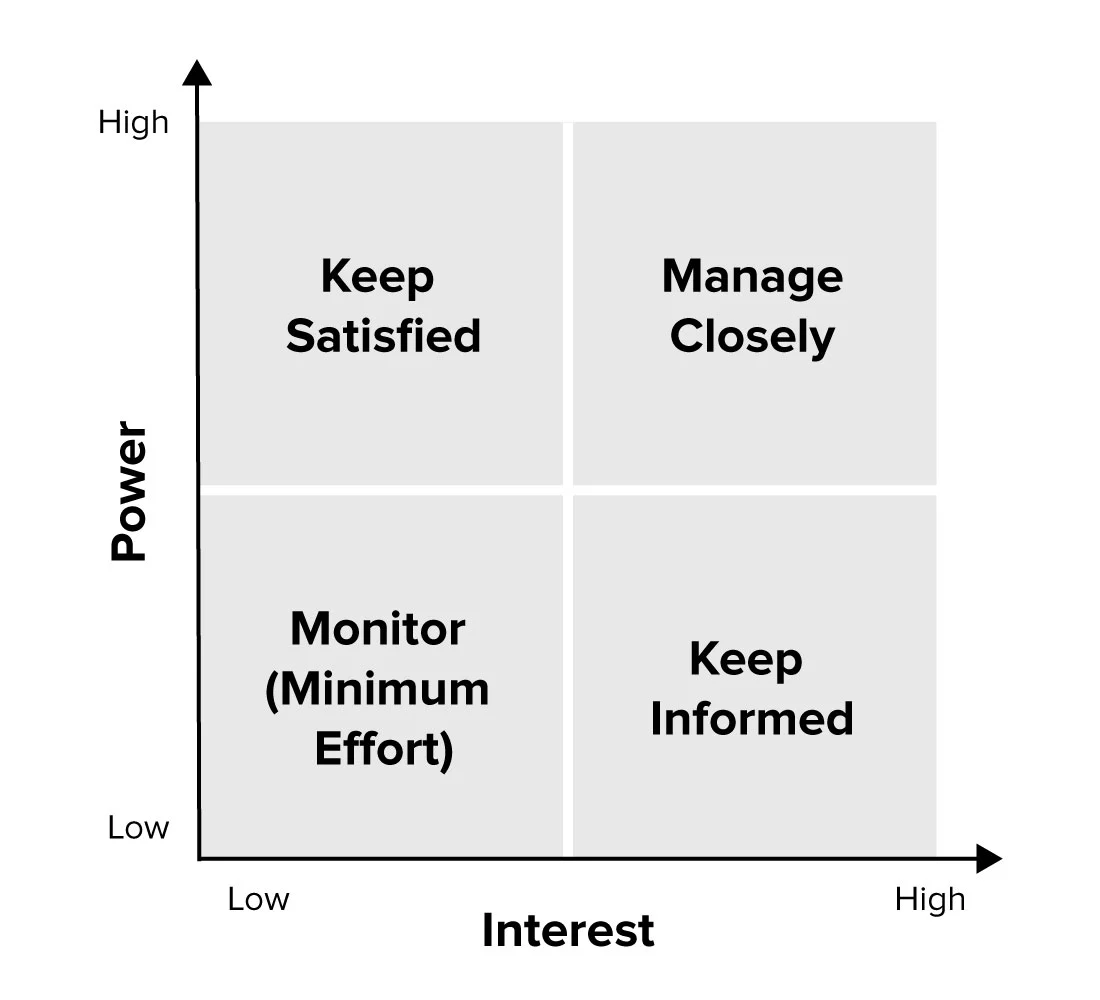What
Stakeholder Maps help identify and classify actors who have Power over and/or interest in the outcomes of a Project or Product development. They help clarify the relationships of internal and external Stakeholders to the project, assess their influence, and choose an adequate Strategy for managing them.
Why
- Get an overview of relevant stakeholders
- Classify them according to power over and interest in product development
- Identify adequate management approaches for each stakeholder
How
- Number of participants: 3–6
- Time needed: depending on the research needed 60 mins to 1–2 days
- Material:
- Sticky notes in different colours
- Thick black markers
- Large board or wall space
- Brown paper
Stakeholder Maps help you identify and prioritise stakeholders and find adequate approaches to managing them. Mapping is best done collaboratively in groups of 3–6 people any may need some preparatory research that looks into all aspects of product development and collects actor information to make sure you don’t miss any relevant stakeholders.
After this preparation, mapping works in the following steps:
- Start by identifying your potential stakeholders. Think of all the people, groups or organizations affected by or contributing to your product, those who have influence or power over its development, and those who have an interest or concern in its success. Write down their names on sticky notes. Try to be as granular as possible – you want to make sure you’re not missing anyone, and you can always consolidate the list later.
- Next, cluster the individual stakeholders into groups that share important attributes – e.g. institutional background, specific interests or role in product development – and name these groups. This helps you consolidate – if you realise that individual stakeholders have the same relationship to your product and its development, you can go forward treating them as a group. It also helps you identify gaps – groups or individuals you have so far missed.
- Prioritise the consolidated stakeholders by placing them in the following Power/Interest Matrix and discussing their placement in your group:

The placement in the matrix represents your relationship to each stakeholder and shows what the adequate way to interact with them is:
High power, high interest
These are the stakeholders that are crucial to your success, as they are affected by it and have the power to influence it. You should fully engage them and make the greatest efforts to meet their needs.
Adequate interaction: Manage Closely
High power, low interest
These stakeholders are potential risks to your success – they aren’t affected by it (or the lack thereof), but can influence it nevertheless. Keep them satisfied, but don’t try to engage them beyond their willingness.
Adequate interaction: Keep Satisfied
Low power, high interest
These stakeholders are affected by what you’re doing, but can’t influence it in relevant ways. Inform and communicate with them to make sure no major issues are arising and to learn from their experience and expectations.
Adequate interaction: Keep Informed
Low power, low interest
These stakeholders are currently neither affected or influential, so don’t put a lot of effort into interactions with them – but make sure you are perceiving any changes in their status, i.e. when they gain power or develop an interest.
Adequate interaction: Monitor
Tips
- Note first, discuss later.
- Make sure that at the end of each step of the process (identify, cluster, prioritise), all participants have contributed the stakeholder information they’re bringing and consent to the results (content of the list, grouping in clusters, locations in the matrix).
- To develop a deeper understanding of a relevant stakeholder, build an Empathy Map for them.
Where
- Can process output of: Empathy Map, Persona
- Can feed input to: Empathy Map, Persona
Caveats
Every 2x2 matrix is a gross oversimplification of the modelled System. The Stakeholder Map should thus be used as a Heuristic Device, not a particularly accurate Model.
In addition, the internal complexity of the stakeholders under consideration also should make us resist reducing them to the two dimensions of the matrix and instead accord them full humanity.
Provenance
This approach to stakeholder mapping is often called the Power/Interest or Mendelow Matrix and usually attributed to Aubrey L. Mendelow (1991), “Environmental Scanning – The Impact of the Stakeholder Concept”.
In reality, it is an adaptation of Mendelow’s original Power/Dynamism Matrix by Gerry Johnson and Kevan Scholes in their Exploring Corporate Strategy, 3rd ed. 1993 (p. 177). They also introduced a wrong publication year for Mendelow’s paper (it was actually published in 1981, not 1991), which has since been reproduced in virtually every article or book mentioning the Mendelow Matrix.
Newer editions of Exploring Strategy now cite Robert Newcombe (2003), “From client to project stakeholders: a stakeholder mapping approach” as the source for the Matrix, who in turn references the 1993 edition of Exploring Corporate Strategy 🤪. It is a useful reference for the Matrix, though, because it explains and contrasts both the original Power/Dynamism (re-labeled as Power/Predictability) Matrix and the more common Power/Interest Matrix, and illustrates their use with a helpful example.
References
- Mendelow (1981): “Environmental Scanning – The Impact of the Stakeholder Concept”
- Johnson and Scholes (1993): Exploring Corporate Strategy, 3rd ed.
- Newcombe (2003): “From client to project stakeholders: a stakeholder mapping approach”